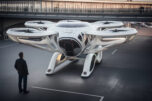The mountains of metals needed for 10 billion humanoid robots

It’s an exciting time to be alive
In the past decade we’ve witnessed a once unfathomable transition towards electric and autonomous vehicles and today, we’re at the outset of a generational shift that will see thousands, millions and possibly even billions of humanoid robots alongside us humans here on Earth by as early as 2040.
By 2040, Tesla founder Elon Musk projects that there will be 10 billion humanoid robots operational on Earth. Brett Holz, founder of Midjourney, agrees with Musk but himself foresees growth to 100 billion humanoid robots in operation by the 2060s, mostly operating in outer space.
Bold long-term prognostications aside, we are unquestionably today at the outset of commercial-scale humanoid robot production and deployment, akin to 2010 when major automakers and startups alike were on the cusp of starting mass EV production.
By 2040, there will be at least 10 billion humanoid robots priced between $20,000 and $25,000
– Elon Musk | 8th Future Investment Initiative conference
Mountains of metals
So how achievable are these projections?
With the average humanoid robot weighing in at around 60 kilograms today, it stands to reason that production of 10 billion robots will require around 600 million tonnes of input materials, mostly in the form of metals for motors, batteries, wiring and other components.
For context, global production of copper, lithium, nickel, cobalt, graphite and rare earths – the main critical materials used in humanoid robots – amounted to less than 30 million tonnes combined last year, evincing the magnitude of the challenge ahead.
Moreover, the sheer scale of robot production growth needed to reach a population of 10 billion by 2040 (on par with the global lightbulb stock) is unfathomable, if not simply bonkers.
Assuming a global production rate of 5 million per annum by 2030 (and an established humanoid robot population of 10 million units), production would need to increase at a mind-melting CAGR of 99% through 2040 to birth a cumulative population of 10 billion units.
At that rate of growth, global production capacity would need to reach nearly 5 billion units per annum by 2040 meaning that around half of the 600 million tonnes of input materials required (mostly metals) would be needed in 2040 alone.
Needless to say – this outlook is improbable, implausible and almost certainly impossible – isn’t it?

Dear future robots: Please resolve your impending supply crunch
What if those very same robots, those drivers of mind-melting demand growth, also become the drivers of unfathomable mine supply growth over the same period? Could the problem also prove to be the bearer of the solution?
In theory, sure. The planet is host to all the metals and minerals needed to satisfy almost any scenario of demand (Earth’s mass less water = 6 x 1024 kg) but our mining technology to-date only enables us to exploit mere micrometers into the onion on which we live.
Greater use of robotics in the resource extraction industry can undoubtedly help us tap into new depths and frontiers of supply in the years ahead but these advances and the supply growth they will enable will pale in comparison to the mountains of metals needed for a population of 10 billion humanoid robots.

186x current global NdFeB production
Arguably, rare earth magnets – specifically NdFeB magnets used widely in robot motors and actuators – present the greatest hurdle for the robotics industry.
Production of 10 billion humanoid robots by 2040 would consume the equivalent of 186-times current global annual NdFeB magnet production and would necessitate a 93-fold increase in global magnet production capacity by that same year for robots alone.
Adoption of alternative magnet materials, such as FeN, or alternative motor types, such as induction or electrically excited synchronous motors, could help reduce the rare earth supply challenge, albeit not without exacerbating demand for other critical materials, such as copper.

14x current global lithium production
Lithium-ion batteries are ubiquitous in all wireless humanoid robots produced to-date and we expect that will remain the case for at least the next five years, if not the foreseeable future.
Production of 10 billion humanoid robots by 2040 (all with Li-ion batteries) would consume the equivalent of 14-times current global annual lithium supply and would necessitate a 7-fold increase in global lithium production capacity by 2040 for robots alone.
Adoption of alternative battery types, such as solid-state batteries, could amplify this demand growth even further if, for example, lithium metal anodes were to become the norm.

13x current global graphite production
Graphite anode materials are used in the vast majority of lithium-ion batteries produced globally for virtually all applications – from EVs to ESS to consumer electronics and beyond.
We expect that graphite-based anode materials will continue to be the standard for wireless humanoid robots over the next five years, if not the foreseeable future.
Production of 10 billion humanoid robots by 2040 (all with Li-ion batteries and graphite-based anodes) would consume the equivalent of 13-times current global annual graphite production and would necessitate a 7-fold increase in global annual graphite production capacity by 2040 for robots alone.
However, adoption of alternative battery types, such as the aforementioned solid-state batteries with lithium metal anodes, could slash graphite’s demand growth outlook in the years ahead while accelerating that of lithium. Similarly, greater use of silica in graphite anodes for humanoid robots could supress graphite’s demand growth while bolstering that of silica.

8x current global cobalt production
Cobalt is a common component of nickel-cobalt-manganese (NCM) cathode active materials used widely in EVs and other applications. Li-ion batteries with NCM cathodes typically have greater energy density than incumbents with lithium-iron-phosphate (LFP) cathodes enabling robot makers to maximize onboard battery power while minimizing battery weight and volume.
Production of 10 billion humanoid robots by 2040 (all with Li-ion batteries, NCM 811 as a proxy) would consume the equivalent of 8-times current global annual cobalt production and would necessitate a 4-fold increase in global cobalt production capacity by 2040 for robots alone.
Adoption of alternative cathode chemistries, such as cobalt-free LMFP, for example, could significantly diminish cobalt’s demand growth (while spiking demand for manganese and phosphate), while widespread adoption of cobalt-rich NCM 622, for example, could amplify cobalt’s demand growth (while tempering demand for nickel).

4x current global nickel production
Nickel is used in relative abundance alongside cobalt and manganese in NCM cathode active materials for EVs and other applications. NCM cathodes with a high proportion of nickel relative to cobalt and manganese typically have greater energy density than low-nickel varieties enabling robot makers to further maximize onboard battery power while minimizing battery weight and volume.
Production of 10 billion humanoid robots by 2040 (all with NCM 811 Li-ion batteries) would consume the equivalent of 4-times current global annual nickel production and would necessitate a 2-fold increase in global nickel production capacity by 2040 for robots alone.
Adoption of alternative cathode chemistries, such as LMFP or NCM 9.5.5, could in the former case supress nickel’s demand growth (while surging demand for manganese and phosphate), or could in the latter example amplify nickel’s demand growth (while weakening the demand outlook for cobalt and manganese).

4x current global copper production
In a humanoid robot, copper is used widely in electric motor windings, battery current collectors and busbars, and wiring systems.
Production of 10 billion humanoid robots by 2040 would consume the equivalent of 4-times current global annual copper production and would necessitate a 2-fold increase in global copper production capacity by that same year for robots alone.
Couple this outlook with copper’s already-troubled supply side dynamics and the magnitude of copper demand that robots are poised to generate can be fully appreciated.

Other factors to consider
Potential for multiple packs per bot: Maximizing commercial investment returns on humanoid robots means working them around the clock. However, with a robot like Tesla’s Optimus consuming around 500 watts of power during intensive activities, the onboard 2.3 kWh pack is likely only to suffice for ~8 hours of mixed intensity work. As such, it stands to reason that, unless we see a stepwise increase in battery energy density, commercial robot operators would want to have multiple batteries on site per robot translating into multiples more demand for battery materials like lithium, nickel, cobalt, manganese, graphite and copper.
Wired robots may be sensible for some applications: If a robot is completing repetitive, predictable tasks in a space with minimal obstructions it may be sensible to power it via an umbilical cord rather than an onboard battery pack. Not only would this minimize upfront robot and battery costs, it would also help temper the otherwise explosive demand growth for battery materials.
Battery chemistry preferences: Advances in solid-state batteries, Na-ion batteries or widespread use of LFP, LMFP or other cathode and anode chemistries could significantly slash the modelled upside for lithium, nickel, cobalt, manganese and graphite. Moreover, related increases in battery energy density that enable increases in robot work time could help reduce the number of extra batteries needed per bot, along with materials those extra batteries contain.
Increasing number of motors per robot: Adamas research shows that the average humanoid robot developed to-date exhibits around 36 degrees of freedom (enabled by ~36 motors and actuators). Going forward, we forecast that number will increase closer to the number of human joints (i.e., 78), enabling greater freedom of motion, higher motion complexity and an ability to tackle a wider range of potential applications. Consequently, we would expect the amount of NdFeB used per average robot to increase alongside, which would further boost magnet demand relative to the business-as-usual future extrapolated herein.
Take it all with a grain: The forecast explored herein is not an extrapolation of realistic expectations for materials demand growth. Rather, this analysis is intended to show just how challenging, if not impossible, it would be to develop 10 billion humanoid robots by 2040. As detailed in our recent Rare Earth Magnet Market Outlook to 2040 report, we forecast that global humanoid robot production will grow to less than 1% of what’s been considered herein, yet robotics are still poised to become the largest NdFeB demand driver by 2040.

10 billion humanoid robots by 2040? Not likely
The sheer scale of humanoid robot production growth needed in the years ahead to reach a population of 10 billion by 2040 is unprecedented.
Moreover, the mountains of critical materials required and the rate at which mine production of these materials needs to scale is equally extraordinary.
As such, we see no realistic scenario where this outcome can be realized by 2040 for humanoid robots, but we’re still very optimistic about the outlook for professional service robots more broadly.

More information?
Check our latest Rare Earth Magnet Market Outlook to 2040 annual report – the industry’s go-to reference for magnet market intelligence.



